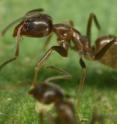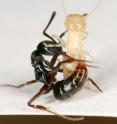Researchers find Asian needle ants displacing other aggressive invaders
Researchers from North Carolina State University have found that one of the most aggressive invasive ant species in the United States -- the Argentine ant -- appears to have met its match in the Asian needle ant. Specifically, the researchers have found that the Asian needle ant is successfully displacing Argentine ants in an urban environment, indicating that the Asian needle ant -- with its venomous sting -- may be the next invasive species to see a population boom. In the world of invasive species, the Argentine ant (Linepithema humile) is a success story. Its aggressive, territorial behavior and ability to create huge "supercolonies" -- consisting of thousands of queens and millions of workers -- have enabled the Argentine ant to spread across the United States, displacing native species and changing ecosystems to suit its needs. No other ant species had been seen successfully pushing back -- until now.
In 2008, while watching a supercolony of Argentine ants in an urban environment, former NC State Ph.D. student Dr. Eleanor Spicer Rice noticed that Asian needle ants (Pachycondyla chinensis) were living and working in the area. This was surprising because Argentine ants normally do not tolerate any other ant species in their territory, so Spicer Rice decided to investigate further.
Over the next four years, Spicer Rice found that Argentine ants appeared to ignore Asian needle ants, and the Asian needle ants took advantage of the situation to displace a significant portion of the Argentine ant population. In 2008, Argentine ants had populations in 99 percent of the sites within the study area, while only 9 percent of the sites were home to Asian needle ant populations. By 2011, Argentine ants were found in only 67 percent of the sites -- while the Asian needle ants had expanded to occupy 32 percent of the sites. The two ant species shared 15 percent of the sites in common.
"This is the first time we've seen another ant species take territory from Argentine ants," says Spicer Rice, lead author of a paper on the research.
The researchers think that the Asian needle ant's ability to tolerate cooler temperatures may play a significant role in its ability to push out Argentine ants. During cold weather, both ant species become fairly dormant and cease reproducing, limiting their activity and driving their populations down. However, the Asian needle ants become active again much earlier -- beginning to reproduce and build new nests in Argentine ant territory as early as March, while the Argentine ants remain inactive until late April or early May. "The Asian needle ants essentially get a head start," Spicer Rice says.
"If the Asian needle ant is effective at displacing a dominant species -- and it is -- then it could be the next major invasive ant species," says Dr. Jules Silverman, a professor of entomology at NC State and co-author of the paper.
"The Asian needle ant is moving into forests and urban environments at the same time," Spicer Rice says. "And because it is active at cooler temperatures, it could move into a very broad range of territory." The Asian needle ant has already been found in areas ranging from Alabama to New York City to Oregon.
The rise of the Asian needle ant is bad news. Asian needle ants have venomous stings, which can cause allergic reactions in some humans. Asian needle ants also appear to be driving out native ant populations in forests -- including native species that play important roles in ecosystem processes, such as dispersing seeds.
Source: North Carolina State University
Other sources
- Stinging needle ants overtaking other invadersfrom MSNBC: ScienceMon, 11 Feb 2013, 21:01:39 UTC
- Invasive Ants Battle for Turffrom Live ScienceMon, 11 Feb 2013, 20:30:43 UTC
- Asian needle ants displacing other aggressive invadersfrom Science DailyMon, 11 Feb 2013, 16:30:55 UTC
- Asian Needle Ants Displacing Other Aggressive Invadersfrom Science BlogMon, 11 Feb 2013, 14:30:34 UTC
- Researchers find Asian needle ants displacing other aggressive invadersfrom PhysorgMon, 11 Feb 2013, 14:30:18 UTC

